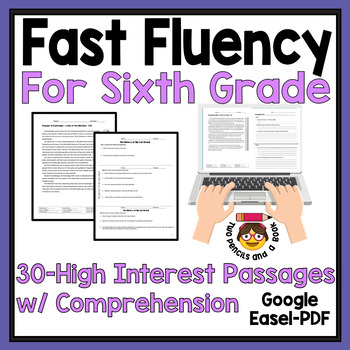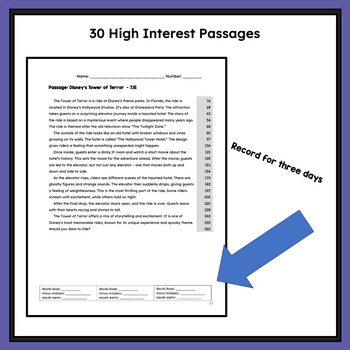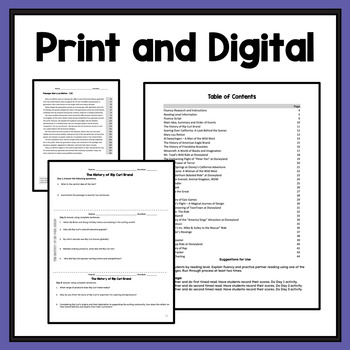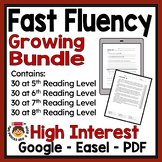Fast Fluency for Sixth Grade: Fluency Tracking: 10 Minutes a Day: 30 Passages
- Zip
- Google Apps™

Also included in
- This is a print-n-go - turn-key fluency and comprehension program at the fifth - 9th grade reading level. High interest topics, detailed instructions and research. With standards based quick work - comprehension, summary, main idea. Track fluency in just 10 to 15 minutes per day at topics students lPrice $15.91Original Price $25.46Save $9.55
- Giant Intervention Bundle. High interest - low level reading comprehension, fluency and phonics program for secondary students. This program is perfect for older struggling readers. Print and digital phonics, multi-syllable word work, intervention reading comprehension, fluency and word work.DownloPrice $269.00Original Price $378.78Save $109.78
Description
This is a turn-key fluency and reading comprehension program at the sixth grade reading level. Google slides are included. High interest topics, detailed instructions and research. With standards based quick work - comprehension, summary, main idea. Track fluency in just 10 to 15 minutes per day at topics students love.
The Fluency program is a comprehensive, simple, and research-based that builds students’ reading fluency in just minutes a day. For students in grades 5 -12, this peer-driven solution pairs same-skill-level students to read age-appropriate and record each other's progress with fluency and accuracy to meet today's career and college readiness challenges.
This set is 30 passages at the 6th Grade reading level.
Thirty passages with three days of standards-based work for each. Google slides, Easel and pdf.
Look at the preview for to know exactly what is in the resource.
Suggestions for Use: Partner students by reading level. Explain fluency and practice partner reading using one of the first passages. Run through process at least two times.
Each passage:
Day 1: Partner and do first timed read. Have students record their scores. Do Day 1 activity.
Day 2: Partner and do second timed read. Have students record their scores. Do Day 2 activity.
Day 3: Partner and do second timed read. Have students record their scores. Do Day 3 activity.
This is an evidence-based strategy for improving reading fluency. The student is asked to read the same passage three to five times, receiving feedback each time from the instructor or peer reviewer. Since this program is peer-to-peer, feedback comes from peers. By providing feedback on accuracy, rate and expression, students can incorporate those changes into each subsequent reading, eventually reaching a point of fluency with that particular passage. They can then move on to more difficult assignments.
Repeated readings of text can also contribute to better comprehension, one of the cornerstones of reading throughout life. All schools, from elementary to college, can easily provide students with repeated readings as well as paired passages of the same theme or topic.
For those teachers who want to mix-up full-class fluency lessons, one option is fluency-oriented reading instruction. This evidence-based practice begins with a teacher reading a particular passage aloud while students follow along in silent reading. Then, students read the passage aloud numerous times throughout the week, including echo, choral and partner reading. They also practice the passage for 15-30 minutes daily. At the end of a week, students engage in discussion, writing an essay or performing other activities that prove comprehension of the passage.
Table of Contents
Fluency Research and Instructions
Reading Level Information
Fluency Script
Main Idea, Summary and Order of Events
The History of Rip Curl Brand
Soaring Over California: A Look Behind the Scenes
Mary Lou Retton
Al Swearingen – A Man of the Wild West
The History of American Eagle Brand
The History of Friendship Bracelets
Minecraft: A World of Blocks and Imagination
Mr. Toad’s Wild Ride at Disneyland
The Enchanting Flight of “Peter Pan” at Disneyland
Disney’s Tower of Terror
Radiator Springs at Disney’s California Adventure
Calamity Jane: A Woman of the Wild West
“The Matterhorn Bobsled Ride” at Disneyland
Expedition Everest: Animal Kingdom, WDW
Adam Sandler
Seth Bullock
Catherine the Great
RC Racer
The History of Epic Games
Peter Pan’s Flight – A Magical Journey of Design
The Imagineering of ToonTown at Disneyland
Superman: The Ride
Dorothy Hamill
The History of the “America Sings” Attraction at Disneyland
Lamar Jackson
“Monster’s Inc. Mike & Sulley to the Rescue” Ride
The Riddler’s Revenge
J.J. Watt
Crush’s Coaster
The Teacup Ride at Disneyland
The History of Rap
Fluency Tracker
Fluency Charting
Other Resources Like this One:
- Reading Comprehension & Fluency Passages for High School Students
- Reading Comprehension and Fluency Passages for High School Students Set 1
- Reading Comprehension and Fluency Passages for High School Students Set 2
- BUNDLE High Interest Low Level Reading Comprehension & Fluency for High School
Thank you for looking.







